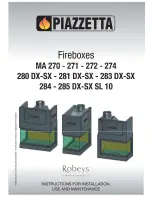
44
|
Regency Horizon® HZ40E-11 Gas Fireplace
installation
Diagram 4
Diagram 3: The upper half of the flashing is installed
under the roofing material and not nailed down
until the chimney is installed. This allows for small
adjustments.
Diagram 2
Unit Installation with Vertical
Termination
4" x 6-5/8" Venting
(Rigid Vent Systems)
1.
Maintain the 1-1/2" clearances (air spaces) to
combustibles when passing through ceilings,
walls, roofs, enclosures, attic rafter, or other
nearby combustible surfaces. Do not pack
air spaces with insulation. Check "Venting"
Sections for the maximum vertical rise of the
venting system and the maximum horizontal
offset limitations.
2.
Set the gas appliance in its
desired location. Drop a plumb
bob down from the ceiling to the
position of the appliance flue exit,
and mark the location where the
vent will penetrate the ceiling. Drill
a small hole at this point. Next,
drop a plumb bob from the roof
to the hole previously drilled in
the ceiling, and mark the spot
where the vent will penetrate
the roof.
3.
A Firestop spacer must
be installed in the floor or
ceiling of every level. To
install the Firestop spacer in a flat ceiling or
wall, cut a 10 inch square hole. Frame the hole
as shown in Diagram 2 and install the firestop.
NOTE:
For best results and optimum perfor-
mance with each approved venting system, it is
highly recommended to apply “Mill-Pac” sealant
(supplied) to every inner pipe connection. Failure
to do so may result in drafting or performance
issues not covered under warranty.
4.
Assemble the desired lengths of pipe and
elbows. Ensure that all pipes and elbow con-
nections are in the fully twist-locked position
and sealed.
5.
Cut a hole in the roof centered on the small
drilled hole placed in the roof in Step 2. The hole
should be of sufficient size to meet the minimum
requirements for clearance to combustibles
of 1-1/2". Slip the flashing under the shingles
(shingles should overlap half the flashing) as
per Diagram 3.
6.
Continue to assemble pipe lengths.
Note: If an offset is necessary in the attic
to avoid obstructions, it is important
to support the vent pipe every 3 feet,
to avoid excessive stress on the
elbows, and possible separation.
Wall straps are available for this
purpose.
Galvanized pipe is desirable above the roofline
due to its higher corrosion resistance. Continue
to add pipe sections through the flashing until the
height of the vent cap meets the minimum height
requirements specified in Dia. 4 or local codes.
Note that for steep roof pitches, the vertical
height must be increased. A poor draft, or down
drafting can result from high wind conditions
near big trees or adjoining roof lines, in these
cases, increasing the vent height may solve
the problem.
7.
Ensure vent is vertical and secure the base of
the flashing to the roof with roofing rails, slide
storm collar over the pipe section and seal with
a mastic.
8.
Install the vertical termination cap by twist-
locking it.
Note: Any closets or storage spaces, which
the vent passes through must be
enclosed.
Diagram 1
Note: All vertical terminations are vented
using 4" x 6-5/8" venting and rigid pipe
adaptor #510-994.
Roof Pitch
Minimum Vent Height
Feet
Meters
flat to 7/12
2
0.61
over 7/12 to 8/12
2
0.61
over 8/12 to 9/12
2
0.61
over 9/12 to 10/12
2.5
0.76
over 10/12 to 11/12
3.25
0.99
over 11/12 to 12/12
4
1.22
over 12/12 to 14/12
5
1.52
over 14/12 to 16/12
6
1.83
over 16/12 to 18/12
7
2.13
over 18/12 to 20/12
7.5
2.29
over 20/12 to 21/12
8
2.44
Содержание Horizon HZ40E
Страница 71: ...Regency Horizon HZ40E 11 Gas Fireplace 71 notes ...
Страница 76: ...76 Regency Horizon HZ40E 11 Gas Fireplace warranty ...
Страница 77: ...Regency Horizon HZ40E 11 Gas Fireplace 77 notes ...
Страница 78: ...78 Regency Horizon HZ40E 11 Gas Fireplace notes ...
Страница 79: ...Regency Horizon HZ40E 11 Gas Fireplace 79 ...
















































